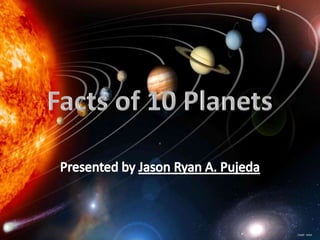Report
Share

Recommended
More Related Content
What's hot
What's hot (20)
Solar system - a powerpoint presentation by Tanisha Pahwa - 5th

Solar system - a powerpoint presentation by Tanisha Pahwa - 5th
Similar to Facts of 10 planets
Similar to Facts of 10 planets (20)
Recently uploaded
God is a creative God Gen 1:1. All that He created was “good”, could also be translated “beautiful”. God created man in His own image Gen 1:27. Maths helps us discover the beauty that God has created in His world and, in turn, create beautiful designs to serve and enrich the lives of others.
Explore beautiful and ugly buildings. Mathematics helps us create beautiful d...

Explore beautiful and ugly buildings. Mathematics helps us create beautiful d...christianmathematics
This presentation was provided by William Mattingly of the Smithsonian Institution, during the fourth segment of the NISO training series "AI & Prompt Design." Session Four: Structured Data and Assistants, was held on April 25, 2024.Mattingly "AI & Prompt Design: Structured Data, Assistants, & RAG"

Mattingly "AI & Prompt Design: Structured Data, Assistants, & RAG"National Information Standards Organization (NISO)
Recently uploaded (20)
Beyond the EU: DORA and NIS 2 Directive's Global Impact

Beyond the EU: DORA and NIS 2 Directive's Global Impact
Seal of Good Local Governance (SGLG) 2024Final.pptx

Seal of Good Local Governance (SGLG) 2024Final.pptx
Basic Civil Engineering first year Notes- Chapter 4 Building.pptx

Basic Civil Engineering first year Notes- Chapter 4 Building.pptx
Measures of Central Tendency: Mean, Median and Mode

Measures of Central Tendency: Mean, Median and Mode
Explore beautiful and ugly buildings. Mathematics helps us create beautiful d...

Explore beautiful and ugly buildings. Mathematics helps us create beautiful d...
Mattingly "AI & Prompt Design: Structured Data, Assistants, & RAG"

Mattingly "AI & Prompt Design: Structured Data, Assistants, & RAG"
Web & Social Media Analytics Previous Year Question Paper.pdf

Web & Social Media Analytics Previous Year Question Paper.pdf
Facts of 10 planets
- 2. The Sun • The sun is biggest than every planets in solar system
- 3. Mercury • Mercury is the smallest and closest to the Sun of the eight planets in the Solar System, with an orbital period of about 88 Earth days. • The diameter of Planet Mercury is 4,878 km • Mercury does not experience seasons in the same way as most other planets, such as the Earth.
- 4. Mercury • Mercury is the smallest and closest to the Sun of the eight planets in the Solar System, with an orbital period of about 88Earth days. • Mercury does not experience seasons in the same way as most other planets, such as the Earth.
- 6. Venus • The planet is named after the Roman goddess of love and beauty. • The atmospheric pressure on the surface of Venus is that 90 times the pressure on Earth. • Venus is classified as a terrestrial planet and is sometimes called Earth's "sister planet" owing to their similar size, gravity, and bulk composition
- 8. Earth • Earth formed approximately 4.54 billion years ago, and life appeared on its surface within its first billion years. • The Earth has only one satellite, the Moon. The Moon is the second brightest object in the sky. • The planet is home to millions of species of life, including humans.
- 10. Mars • Mars is the fourth planet from the Sun and the second smallest planet in the Solar System. • Named after the Roman god of war, it is often described as the "Red Planet", as the iron oxide prevalent on its surface gives it a reddish appearance. • The orbital speed of Mars is 24.2 km per second
- 12. Jupiter • Jupiter, the largest planet in our solar system, is 318 times larger than Earth. • Jupiter is primarily composed of hydrogen with a quarter of its mass being helium, although helium only comprises about a tenth of the number of molecules. • Jupiter's mass is 2.5 times that of all the other planets in the Solar System combined
- 14. Saturn • Saturn is the sixth planet from the Sun and the second largest. • Saturn has a prominent ring system that consists of nine continuous main rings and three discontinuous arcs, composed mostly of ice particles with a smaller amount of rocky debris and dust. • Saturn is termed a gas giant, but it is not entirely gaseous.
- 16. Uranus • Uranus is the third largest planet in the Solar System. • Uranus is similar in composition to Neptune, and both are of different chemical composition than the larger gas giants Jupiter and Saturn.
- 18. Neptune • Neptune is the fourth largest planet in the Solar System. • Neptune was the first planet found by mathematical prediction rather than by empirical observation.
- 20. Pluto • Pluto, formal designation 134340 Pluto, is the second-most-massive known dwarf planet in the Solar System • Pluto is the smallest planet in the Solar System, smaller than Earth’s Moon, and half the width of Jupiter’s moon, Ganymede.
- 21. Computer-generated map of Pluto from Hubble images, synthesized true color and among the highest resolutions possible with current technology.
- 22. •END
